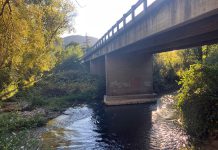Sonoma County may be a land of bounty and beauty, wine and luxury, but it is also a place of wild extremes. Most of the time we shield ourselves from these extremes with our modern appliances, Golden State infrastructure and accumulated wealth. But lately, our extremes have become so extreme that we not only can’t ignore them, but we are now struggling to endure them.
The list of our extremes is easy to memorize: wildfires, floods, atmospheric rivers, ocean acidification and droughts.
Most of the time, we go through years with extreme winter wetness and extreme summer dryness. The problem with extremes is they almost never even out or hit a happy medium. Some years 50% of our total average rainfall of 40 inches can fall in less than 40 hours. On Feb. 28, 2019, almost eight inches of rain fell over the Russian River watershed. That’s more than half of this year’s total rainfall to date. Climate scientists have statistics that show our extremes are getting, well, more extreme. Warmer temperatures mean less snow, which is 30% of California’s water source. Evaporation increases and our landscape dries out quicker. We have a thirstier atmosphere.
Our grapes love our Mediterranean climate, with mild winters and an extended growing season with warm and hot days and cool nights. Another extreme we have is our 24-hour temperature cycle. When there is morning fog, we can wake up in 48-degree weather, only to watch the temperature climb to over 100 degrees like it did last week. That’s a 50-degree swing in a single day. That doesn’t happen at the Sahara Desert or at the polar ice caps.
We grumble that we want things to be normal. Well, droughts are normal in Sonoma County. We’ve been getting them about every decade since weather history has been recorded. If the climate scientists are correct, we can expect more and harsher droughts. The current drought is expected to be our worst in 50 years, topping the drought of 1976-77.
Coincidentally — and not in a good way — 50 years ago was when California constructed the last major water delivery and storage infrastructures, including Lake Sonoma which was delayed by a few years due to environmental lawsuits and completed in 1983.
When we find ourselves facing such extremes as thousands of farmers and their workers losing their jobs and facing market conditions where they could make more money selling their groundwater than raising livestock or crops, something has to change.
Droughts are extremely costly. The drought of 2014-2016 cost $3.8 billion in lost agricultural production, according to the Public Policy Institute of California. (Farming uses 80% of California’s annual water supply.)
Sonoma County farmers already face very dire conditions this year and fear next year could be even worse. Municipal and household use of water is under tight quotas and some mandatory cutbacks. We’d be wise to do even more.
Sonoma County’s elected officials and industry leaders should take the entire rescue, recovery, rebuild and resiliency lessons we’ve learned from our spate of wildfires and create a drought preparedness, prevention and proactive playbook. We know our extremes are here forever. We should strengthen our defenses, build new water supply infrastructure and implement more water conservation programs for our homes and industry.
What would this look like? All homes could have storage tanks full of recycled water for outdoor and other uses. Farmers, dairymen and vineyard owners could add multiple reservoirs and catchment basins to supplement the dry ones they are staring at this season. Public subsidies for low flow home plumbing should be extended. Neighborhoods could mobilize like they have done for local wildfire response planning.
All we know is, answering our changing climate conditions is extremely important.








